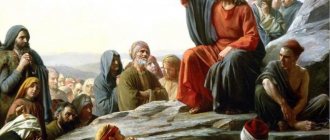Abrahamic religions take their roots in the Middle East, or more precisely in ancient Canaan, whose territories are now divided between Syria, Lebanon, Israel and Jordan. Their main difference from other religions is monotheism, that is, belief in one God the Creator.
The beginning of these religions goes back to the patriarch of the Semitic tribes, Abraham. But it should be noted that he is the founder of the Jewish religion, in the culture of which Christianity and later, at the beginning of the 7th century, Islam appeared.
What are Abrahamic religions?
Judaism, Christianity and Islam are the world's main religions. The most important factors that unite them are the Holy Scriptures (more precisely, the Torah) and faith in the revelation of their teachings.
Meaning of the concept
They are called Abrahamic because the peoples from whom they arose descended from Abraham. In all three religions he is revered as a forefather, but only in Judaism - as a founder. It should be noted that not all representatives of Islam agree with this name.
Abrahamic and Dharmic religions
Dharmic religions (Buddhism, Jainism, Sikhism, Hinduism) mainly find their origin in India. They are called dharmic because they are united by faith in dharma. In simple terms, dharma is a set of teachings that help to understand the structure of life, the universe, and the spiritual world. Their goal is improvement through the implementation of proposed laws.
The common features of the Dharmic and Abrahamic faiths boil down to the fact that both of them offer their followers a certain concept containing a set of rules that will help them achieve spiritual perfection.
As for their teaching and philosophy, the differences are quite serious.
Dharmic religions profess the doctrine of many gods (except Buddhism, where the idea of the existence of God is rejected).
Their concept of divinity is different. In monotheistic teachings, only the creator of the universe is called God, but in dharmic teachings this concept is distorted and vague. Their sources of teaching are completely different: for some, the basis is divine revelation, for others - the philosophical views of their teacher or teachers.
Diet restrictions
Judaism and Islam maintain strict dietary rules. These two beliefs prohibit the consumption of pork. Islam does not allow the consumption of alcoholic beverages of any kind.
With few exceptions, Christians do not consider the strict dietary laws of the Old Testament to be relevant to the church today.
The Roman Catholic Church believes in the practice of abstinence and penance. Thus, all Fridays throughout the year and the days of Great Lent become days of repentance. The law of abstinence requires Catholics from the age of 14 to abstain from eating meat on Fridays in memory of the suffering of Jesus on Good Friday.
According to the Christian Bible, the consumption of strangled animals and blood was prohibited by the Apostolic Decree and is still prohibited in the Greek Orthodox Church.
Jehovah's Witnesses abstain from eating blood.
History of the term
Abraham (originally Abram) was born around the 19th century BC. in the Sumerian city of Ur, one of the most important cities of Ancient Mesopotamia. Terah, the father of Abraham, taking him, his daughter Sarah and his nephew Lot, left Ur and went to Canaan, but died on the way. Abraham married Sarah (later Sarah), his blood sister. She was his father's daughter by another woman.
Abraham made a covenant with God. In it, God promised that he would have a huge offspring. This is where the biblical phrase “God of Abraham” originates. The sign of the covenant was circumcision.
Abraham's wife Sarah was barren, and she allowed her husband to conceive a child with her slave Hagar. Hagar gave birth to a son, who was given the name Ishmael. Sarah gave birth when she was already very old. Her son, Isaac, was recognized by Abraham as the firstborn, and Hagar and Ishmael were kicked out because he laughed at Isaac.
After the death of Sarah, Abraham had several more children, who, according to legend, together with Ismail, were the ancestors of the Arab tribes. And Isaac continued the Jewish family.
In the minds of Abraham's descendants, the memory of the God of their father was preserved. This marked the beginning of the development of the Abrahamic religions.
What are the Abrahamic religions?
The main representatives of this group are: Judaism, Christianity and Islam. The first two have more in common with each other in religious and historical terms. Islam originated later and in a different culture.
Judaism
The most ancient of the above religions is Judaism. She is directly related to her ancestor. Its name comes from the name of Judah, one of the sons of Jacob (grandson of Abraham). Judaism is mainly practiced by Jews, although there are currently no racial restrictions on membership. In the past there were quite severe restrictions. Only Jews could practice this religion.
The Jewish canon of sacred books is called the Tanakh.
It is divided into three parts:
- Law (Torah);
- Prophets (Nevi'im);
- Scriptures (Ketuvim).
God is perceived as the creator of the world, man and all living things. The relationship with God is regulated by strict rules. These are the first four of the Ten Commandments given to Moses on Mount Sinai. Judaism also practices circumcision as a symbol of the covenant with God.
Followers of Judaism await the Messiah, the redeemer and the king who was promised to them in the Tanakh.
Christianity
The founder of Christianity is Jesus Christ. The religion began around the 1st century AD. Christianity is a continuation and improvement of Judaism. There have never been any restrictions on conversion to this religion; it is universal. The most numerous Christian denominations are Orthodoxy and Catholicism.
God in Christianity is viewed as a creator, united in three forms: Father, Son and Holy Spirit. Jesus Christ is the son of God, one of the hypostases of the Holy Trinity, the Messiah promised in the Old Testament. The role of Christ is seen as the savior of souls and the reconciler of man and God.
The canon of Holy Scripture includes:
- Old Testament (which contains the same books as the Tanakh);
- New Testament (Gospel and Apostle).
The Gospel (good news) was written by four authors: Matthew, Mark, Luke and John. The Apostle contains the Book of Acts, the Epistles of the Holy Apostles and the Apocalypse.
Followers of this religion accept the commandments that the Tanakh contains, but in a Christian interpretation: the commandments must be fulfilled not only in the external aspect, but also in the moral aspect.
Islam
Islam is the youngest of these three religions. Followers of Islam accept the Torah and revere Jesus Christ as a prophet, rejecting his divine origin. The main prophet is Muhammad. The doctrine of Islam states that the world of spirits consists of angels and jinn.
In terms of worshiping God (Allah), Islam is distinguished by a more strict attitude towards its doctrines. Worshiping anyone other than Allah is strictly prohibited.
Holy Scripture in Islam:
- Taurat (Torah);
- Zabur (psalter);
- Injil (Gospel);
- Suhuf (Scrolls);
- Koran.
Basically, the holy books of Islam contain paraphrases of the Bible and additions written by prophets.
Source of religions
These religions have another name - religions of revelation. They are called so because the source of knowledge of divine secrets for them is revelation.
Revelation is the process by which God reveals himself, his properties, secrets and plans. It occurs invisibly through chosen people called prophets.
Most of the most important revelations are contained in the Torah.
Origin and history of religions
Judaism is considered the creed of the descendants of Jacob, the grandson of Abraham. Unlike other ancient gods of the Near East, the Jewish Lord is depicted as unitary and solitary.
Ethical monotheism is central to all sacred or normative texts. But it was not always observed in practice. The Hebrew Bible condemns the worship of other gods in ancient Israel. During the Greco-Roman era, Judaism had many different interpretations of monotheism, including the interpretations that gave rise to Christianity.
Christianity emerged as a Jewish sect in the Middle East in the mid-1st century. Besides Judaism, the primary religious influences on early Christianity are Zoroastrianism and Gnosticism. Christian ideas such as the end of the world, final judgment, resurrection, heaven and hell arose from Zoroastrian beliefs. The early development of this religion took place under the leadership of the remaining twelve apostles, especially Peter and Paul, who were followed by the early bishops, whom Christians consider to be the successors of the apostles.
According to the scriptures, Christians were persecuted from the very beginning by some Jewish and Roman religious authorities who did not agree with the teachings of the apostles.
Similarities
Abraham's God is the eternal, omnipotent, omniscient creator of the Universe. Properties of God:
- holiness;
- justice;
- omnipotence;
- omnipresence.
Proponents of the Abrahamic faith believe that he is transcendent yet personal and involved, hearing prayers and responding to the actions of his creatures.
In the documents of all three faiths there are descriptions of the same places, events and characters, although their meanings are not similar.
For Jews, Abraham appears as the patriarch of the children of Israel. The Lord promised him: “I will make you a great nation, and I will bless you.” With Abraham, God entered into “an everlasting covenant throughout the ages to be a God to you and to your future.” This commandment makes Abraham and his descendants children of the Covenant. Likewise, the converts who join the Covenant are all identified as sons and daughters of Abraham.
Abraham is a revered ancestor, or patriarch, to whom the Lord made several promises so that he would have countless descendants who would receive the land of Canaan (“Promised Land”).
Christians view Abraham as an important example of faith and a spiritual and physical ancestor of Jesus. In the Christian denomination, Abraham is the role model of faith, seen as the harbinger of the offering to God of his son Jesus.
For Muslims, Abraham is a prophet to whom God gave revelations.
Ibrahim (Abraham) became the first in the genealogy of Muhammad. Islam considers him one of the first Muslims - the first monotheist in the world. Just like Judaism, Islam believes that Abraham rejected idolatry through logical reasoning. Abraham is also remembered in some detail of the annual pilgrimage, the Hajj.
Differences
Worship and Religious Rites
Worship and rituals are different. The Abrahamic religions have a similarity: a seven-day cycle, with one day set aside for worship or prayer - Shabbat, Saturday or Jumuah. This custom is associated with the biblical story of Genesis, where the Lord created the Universe in six days and rested on the seventh.
Judaism is guided by the interpretation of the Torah and Talmud. Before the destruction of the temple in Jerusalem, Jewish priests offered sacrifices there twice a day. A Jewish man is required to pray three times a day. Other practices include:
- circumcision;
- dietary laws;
- Easter;
- Torah study and others.
Jewish women's prayer obligations vary by denomination. In modern practice, women do not read commandments from the Torah.
All branches of Judaism share a common calendar containing many events, with lunar months and a solar year (an extra month is added every second or third year to make the lunar year shorter, to "catch up" with the solar year).
Christian worship varies from denomination to denomination. Individual prayer is usually not ritualized, but group prayer is ritual or non-ritual, depending on the occasion. During church services, some kind of liturgy is often accompanied. Rituals are performed during sacraments, which also vary from denomination to denomination and usually include:
- baptism;
- participle;
- confession.
Followers of Islam (Muslims) must abide by the five pillars of Islam.
- The first pillar is faith in the unity of Allah, and in Muhammad is his last and most perfect prophet.
- The second is the obligation to pray five times a day in the direction of the Kaaba in Mecca.
- The third is giving alms, a share of wealth given to the poor, which means giving a certain share of one's wealth and savings to the people, as prescribed in the Qur'an. The normal share to be paid is two and a half percent of earnings. It increases if it is unearned wealth (discovering treasure).
- The fourth is fasting during the month of Ramadan. Only people in good health fast when they reach 18 years of age. Women during their menstrual cycle or those with diabetes may not fast. Days missed from fasting must be made up - the fasting person must feed the poor.
- The fifth is making a pilgrimage to Mecca. Every self-respecting Muslim does this once a year.
History and origin of religions
The starting point of the origin of Judaism can be considered the covenant of God with Abraham. But the formation of Judaism as a religion occurred under Moses, after the removal of the Jews from Egyptian slavery. It was then that scriptures, doctrines, laws, cults, etc. began to appear. This does not mean that the Jews did not have all this before - they did, but in oral form and in a simplified form, and they were lost during their time in slavery.
Christianity arose as a reaction to the degradation of Judaism at that time. This judgment arises from the fact that Christ often came into conflict with Jewish movements, such as Pharisaism, Sadducees, etc. It begins in the 1st century with the appearance of Christ to preach.
The emergence of Islam can be called a reaction to paganism, which dominated Western Arabia at that time. Islam was founded by the prophet Muhammad in the 7th century in the city of Mecca. Then he was expelled to Medina, from where, having strengthened himself and gathered a sufficient number of followers, he returned. In spreading his faith, the Prophet Muhammad paid attention more to political and legal issues than to theological ones. Islamic theology traces the influence of Christianity and Judaism, but it characterizes the latter as distorting the teachings of Holy Scripture.
Judaism, Christianity and Islam
The three most influential monotheistic religions in world history are Judaism, Christianity and Islam. All of them originated in the Middle East, and each was influenced by the others.
Judaism
Judaism is the oldest of these three religions, dating back to approximately the first millennium BC. e. The ancient Hebrews were nomads who lived in and around Ancient Egypt. Their prophets, or religious leaders, partly derived their ideas from the religious beliefs of the region, but were distinguished by their adherence to one omnipotent God. Most of their neighbors were polytheists. The ancient Jews believed that God required submission to strict moral laws and stubbornly insisted that they had a monopoly on truth, considering their beliefs to be the only true religion (Zeitliti
1984, 1988).
Until the creation of the State of Israel shortly after the end of World War II, there was no state in which Judaism was the official religion. Jewish communities continue to exist in Europe, North America and Asia, although they were often subject to persecution, culminating in the murder of millions of Jews by the Nazis in concentration camps during the war.
Christianity
Many concepts from Judaism were adopted and incorporated into Christianity. Jesus was an Orthodox Jew, and Christianity began originally as a sect of Judaism; It is not entirely clear whether Jesus wanted to found a separate religion. His disciples perceived him as the Messiah
(Hebrew word meaning "anointed one", which in Greek corresponds to the word "Christ") expected by the Jews. Paul, citizen of Rome, who spoke
Varieties of Religion
Table 17.1
Religious affiliation of the world's population. 1993
| Religion | Number of adherents | Percentage of total |
| Christians | 1869282 470 | 33,5 |
| Catholics | 1 042 501 000 | 18,7 |
| Protestants | 382 374 000 | 6,9 |
| Orthodox | 173 560000 | 3,1 |
| Anglicans | 75 847 000 | 1,4 |
| Other Christians | 195 000470 | 3,5 |
| Muslims | 1014 372 000 | 18,2 |
| Non-believers | 912 874 000 | 16,4 |
| Hindus | 751360 000 | 13,5 |
| Buddhists | 334 002 000 | 6,0 |
| Atheists | 242 852 000 | 4,3 |
| Chinese folk religions | 140 956 000 | 2,5 |
| Followers of new religions | 123765 000 | 2,2 |
| Followers of tribal religions | 1,8 | |
| Sikhs | 0,4 | |
| Jews | 0,3 | |
| Others | 49280 000 | 1,0 |
Source:
Statistical Abstract of the United States. 1994. P. 855.
in Greek, was the main initiator of the spread of Christianity, widely preaching Christianity in Asia Minor and Greece. Although Christians were severely persecuted, Emperor Constantine eventually adopted Christianity as the official religion of the ■ Roman Empire. As Christianity spread, it became the dominant force in Western culture for the next two thousand years.
Today Christianity has a large number of adherents and is more widespread in the world than any other religion. Over a billion people consider themselves Christians, but there are many subdivisions of Christianity that differ among themselves on issues of theology and church organization; The main branches are Catholicism, Protestantism and Orthodoxy.
Islam
The origins of Islam, currently the second largest religion in the world (see Table 17.1), largely coincide with the origins of Christianity. Islam dates back to the teachings of the Prophet Muhammad in the 7th century. n. e. The only god of Islam - Allah - is believed to rule over the lives of all people and over all nature. The Pillars of Islam are the five main religions
important duties of Muslims (as adherents of Islam are called). The first is a repetition of the Islamic creed: “There is no God but Allah, and Muhammad is His prophet.” The second duty is to perform the prescribed prayer five times daily, followed by ritual ablution. During prayer, the person praying must always face the holy city of Mecca in Saudi Arabia, no matter how far from Mecca he may be.
The third pillar is the observance of Ramadan, a month of fasting during which no food or drink is allowed during the daytime. The fourth duty of Muslims is the distribution of alms (money to the poor), which was determined according to Islamic law and was often used by the state as a source of taxation. Finally, every believer is expected to make a pilgrimage to Mecca at least once in his life.
Muslims believe that Allah first spoke through older prophets before Muhammad - including Moses and Jesus - but that Muhammad's teachings more directly express his will. Islam has become very widespread in the world; it has over a billion followers, most of whom are concentrated
Chapter 17. Religion
in North and East Africa, the Middle East and Pakistan. (Muslim beliefs are briefly discussed in the section “Islamic Fundamentalism” on p. 488).
Religions of the Far East
Hinduism
There are important differences between Judaism, Christianity and Islam, on the one hand, and the religions of the Far East, on the other. The oldest of all the great religions known in the modern world is Hinduism,
whose main beliefs date back to around the sixth millennium BC. e. (The example given at the beginning of this chapter was borrowed from this religion). Hinduism is a polytheistic religion. It is so internally heterogeneous that some scholars have proposed viewing it as a collection of related religions rather than as a single religious system; Many local cults and religious practices are linked by a few common beliefs.
Most Hindus believe in the cycle of reincarnation
- the teaching that all living beings are part of the eternal process of birth, death and rebirth. The second key feature is the caste system, based on the belief that people are placed at birth in a certain position in the social and ritual hierarchy in accordance with the nature of their activities during previous incarnations. Each caste has its own special set of duties and rituals, and the fate of each person in the next life depends mainly on how well he fulfills his duties in this life. Hinduism recognizes the possibility of many different religious views, without making a clear distinction between believers and non-believers. There are over 750 million Hindus in the world, almost all of whom live on the Hindustan Peninsula. Unlike Christianity and Islam, Hindus do not seek to convert others to the “true faith.”
Buddhism, Confucianism, Taoism
Ethical religions of the East include Buddhism, Confucianism
and
Taoism.
There are no gods in these religions. On the contrary, they bring to the fore ethical ideals that
connect the believer with the natural harmony and unity of the universe.
Buddhism
dates back to the teachings of Siddhartha Gautama, nicknamed Buddha (Sanskrit “enlightened one”), an Indian prince of a small kingdom in Southern Nepal in the 6th century.
BC e. According to the teachings of the Buddha, human beings can escape the circle of reincarnation by renouncing desires. The path to salvation lies in a life of self-discipline and meditation, separated from the worries of worldly life. The ultimate goal of Buddhism is to achieve nirvana
complete spiritual perfection. Buddha rejected Hindu rituals and the power of castes. Like Hinduism, Buddhism has many local variations associated with belief in local gods, and does not require unity of views from its adherents. Buddhism is now an influential force in several countries in the Far East, including Thailand, Myanmar, Sri Lanka, China, Japan and Korea.
Confucianism
formed the basis of the culture of the ruling groups in traditional China.
Confucius (the Latinized form of the name Kun-fuzi - “teacher Kun”) lived in the 6th century. BC e., in the same era as the Buddha. Like Lao Tzu, the founder of Taoism, Confucius was a teacher and not a religious prophet, unlike religious leaders in the Middle East. Confucius' followers do not consider him a god, but see him as "the wisest of wise men." Confucianism seeks to adapt human life to the inner harmony of nature, paying special attention to the veneration of ancestors. Taoism
adheres to similar principles, emphasizing meditation and non-violence as the path to the higher life. As a result of targeted government opposition, Confucianism and Taoism lost much of their influence in China, although some elements of these religions survive in the beliefs and practices of many Chinese to this day.
Theories of religion
Sociological theories of religion are still heavily influenced by three “classic” sociological theorists: Durkheim, Marx and Weber. None of the three scientists mentioned was himself an adherent of any religion, and all of them were of the opinion,
Theories of religion
that the importance of religion in modern society will decrease. Each of them believed that religion, in some fundamental sense, is an illusion. It is possible that adherents of various faiths are absolutely confident in the validity of the beliefs they hold and the rituals in which they participate, and yet the very diversity of religions and their obvious connections with different types of society, as the three thinkers mentioned, believed, make such claims initially untenable. A person born into an Australian hunter-gatherer society will obviously have different religious beliefs than someone born into the caste system of India or the Catholic Church of medieval Europe.
Marx and religion
Despite the fact that Marx's views influenced the understanding of this problem, he never dealt specifically with religion. His views on this issue go back in large part to the writings of several earlier theologians and philosophers of the early 19th century. One of them was Ludwig Feuerbach, author of the famous work "The Essence of Christianity" (Feuerbach
1957, originally published 1841). According to Feuerbach, religion consists of concepts and values created by human beings in the course of the development of their culture, but erroneously projected onto divine powers or gods. Because human beings do not fully understand their own history, they tend to attribute socially created values and norms to the actions of gods. Thus, the story of the Ten Commandments received by Moses from God is a mythical version of the origin of the moral precepts that guide Jewish and Christian believers in their lives.
According to Feuerbach, “until we understand the nature of the religious symbols that we ourselves have created, we are doomed to be prisoners of the forces of history beyond our control.” Feuerbach uses the term alienation
to denote the creation of gods and divine powers other than human beings.
The values and concepts created by people begin to be perceived as the product of alien
or extraneous beings - religious forces and gods. Although the consequences
alienations in the past were negative, the understanding of religion as alienation is, according to Feuerbach, promising for the future. Once human beings realize that the values they project onto religion are actually their own, it becomes possible to realize those values on earth rather than putting them aside for the afterlife. The power that Christians believe God possesses can be appropriated by human beings themselves. According to the Christian faith, God is all-powerful and all-merciful, while human beings are imperfect and flawed. However, Feuerbach believed that the potential for love and kindness, as well as the ability to control one's own life, are inherent in people's social institutions and can be brought to life once people understand their true nature.
Marx agreed with the view that religion represents human self-alienation. Many people believe that Marx did not recognize religion, but this is far from true. Religion, he wrote, is “the heart of a heartless world,” a refuge from the cruelty of everyday life. According to Marx, religion in its modern form will and must disappear, but this will happen because the positive values embodied in religion can become guiding ideals for improving the fate of the human race on earth, but not because these ideals and values themselves are in themselves wrong. We should not fear the gods we ourselves have created, and we should stop ascribing to them values that we can embody ourselves.
It is widely known that Marx said that religion is “the opium of the people.” Religion postpones happiness and reward for later - for the afterlife, teaching people to submissively accept the existing conditions of life. Attention is thus diverted from inequality and injustice in this world by the promise of hope for what is to come in the next world. Religion has a strong ideological component: religious beliefs and values often serve as justification for inequalities in the distribution of wealth and power. For example, the teaching that “the poor in spirit will gain the whole world” fosters an attitude of humility and non-resistance to oppression.
Chapter 17. Religion
Durkheim and religious ritual
Unlike Marx, Emile Durkheim devoted a significant part of his scientific work to the study of religion, focusing especially on religion in small traditional societies. Durkheim's book The Elementary Forms of Religious Life, first published in 1912, is probably one of the most influential studies in the sociology of religion .
1976). Durkheim does not associate religion primarily with social inequality or power, but relates it to the general nature of social institutions. The basis of his book is an examination of totemism as it exists in Australian Aboriginal societies, and he believes that totemism represents religion in its most "elementary" or simple form - hence the title of his book.
A totem, as already mentioned, is originally an animal or plant to which a special symbolic meaning is attributed to a given group of people. This is sacred
an object that evokes worship and is accompanied by various ritual actions.
Durkheim defines religion based on the distinction between the sacred and the profane. He argues that sacred objects and symbols are seen as standing apart
from the routine aspects of existence that constitute the realm of the profane. It is generally forbidden, except in special ritual ceremonies, to eat a totem animal or plant, and as a sacred object, the totem is believed to have certain sacred properties that completely separate it from other animals that can be hunted or plants that can be collected and collected. to eat.
Why is the totem considered sacred? According to Durkheim, because it is a symbol of the group itself: it stands for the values central to that group or community. The reverence that people feel towards the totem actually arises from the reverence they feel for basic social values. In religion, the object of worship is essentially society itself.
Durkheim insistently emphasized that religion is not just beliefs. Any religion involves a regular ceremony and ritual actions in which the entire group of believers takes part, gathered
together. In such collective ceremonies, a sense of group solidarity is maintained and strengthened. Rituals distract people from the worries of mundane social life and take them to sublime spheres, where people feel contact with higher powers. These higher powers, attributed to totems, divine influences or gods, are in fact nothing more than the expression of the influence of the collective principle on the individual.
Ceremony and ritual, according to Durkheim, play an important role in uniting members of groups. This is why they are observed not only in regular worship situations, but also in various life crises when people experience major social changes such as birth, marriage and death. In almost all societies, rituals and ritual procedures are observed in these situations. Durkheim argues that collective rituals maintain group solidarity at times when people are forced to adapt to major changes in their lives. Funeral rituals demonstrate that the values of a given group do not die with the death of an individual, and thus provide bereaved people with the opportunity to adapt to their changed circumstances. Mourning is not a spontaneous expression of grief, or at least it is only such for those who are personally affected by the loss. Mourning is a duty imposed by the group.
In small traditional cultures, Durkheim argued, almost every aspect of life is imbued with religion. Religious rituals simultaneously generate new concepts and categories and confirm existing values. Religion is not simply a set of beliefs and actions; in traditional cultures it actually determines the way of thinking
person. Even the most fundamental categories of thought, including the understanding of the categories of time and space, were originally formulated in religious terms. For example, the concept of "time" originally arose from the counting of breaks in religious rituals.
Durkheim believed that as modern societies develop, the influence of religion weakens. Scientific thinking is increasingly replacing religious explanation, and ceremonial and ritual actions are gradually being limited.
Theories of religion
are present and occupy only a small part of an individual’s life. Durkheim agrees with Marx that traditional religion, i.e. religion associated with belief in divine powers or gods is on the verge of extinction. “The old gods are dead,” writes Durkheim. At the same time, he says that there is a function in which religion, in modified forms, is likely to continue to exist. Even today, the unity of modern societies depends on rituals to support their values, and one can therefore expect that new ritual activities will arise to replace old ritual activities. Durkheim is somewhat vague about what they will be, but he seems to have in mind celebrations in honor of such humanistic and political values as freedom, equality and social cooperation.
Common and distinctive features
Although the theology of these religions has developed in different cultures and under different circumstances, some common doctrines have remained at the core of their concepts.
Common features that unite these religions:
- Belief in God as a creator, in his omnipresence and omnipotence.
- The source of their fundamental doctrine is the same, and the faith in the divine revelation by which it is received.
- Belief in the angelic world and the afterlife.
- The doctrine of the necessity of moral life.
- Worship of Abraham
The development of theological thought of each of them followed its own path. The emergence of ever greater differences between them was inevitable. In addition to theology, history, politics and other factors contributed to this.
Distinctive features:
- Confession of God in three hypostases is unique to Christians.
- Attitude to the person of Christ. For Muslims he is a prophet, for Jews he is an impostor, for Christians he is the son of God.
- Cult. In all three cases it is different. Different holidays, rituals, different times for fasting, etc.
- Although everyone believes in an afterlife, ideas about it vary.
- Icons are allowed only in Christianity.
Relationships between religions
Islam and Judaism are closer to each other. Judaism recognizes Islam because the latter preaches monotheism. And historically, Jews were treated better in Islamic countries. The Ottoman Empire was a refuge for Jews expelled from Spain by the Catholic Church.
Christianity and Judaism have had a complex relationship from the very beginning of their existence. The Jewish high priests asked Pilate to crucify Jesus Christ.
Islam and Christianity were at odds more during times of territorial disputes. Such an example is the Crusades, etc.
In the modern world, relations between them are tolerant. Theological disputes take place in the form of debates. Joint worship services between their representatives, of course, are not held, but fraternal meetings are held.











